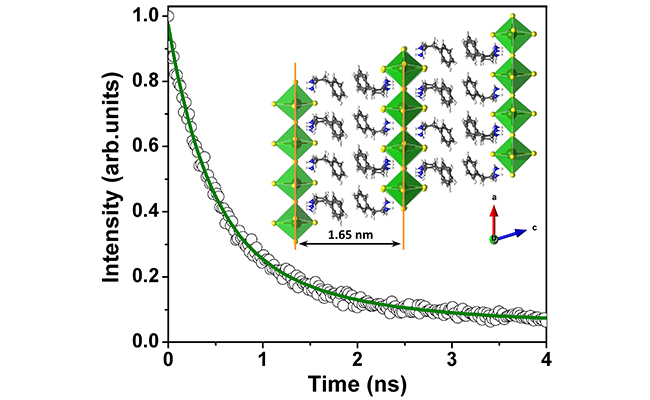The research group led by Prof. HAN Keli from Dalian Institute of Chemical Physics (DICP) of the Chinese Academy of Sciences (CAS) has made a progress in the study of the dynamic mechanism of two-dimensional lead-free perovskite materials. This work has been published in The Journal of Physical Chemistry Letters.

Structural illustration of the layered 2D perovskite (PEA)2GeI4 and room-temperature PL spectrum of 2D (PEA)2GeI4 and 3D MAGeI3
Organic-inorganic hybrid perovskites are widely used in the photovoltaic field, in view of their high absorption coefficients, long charge carrier diffusion lengths, and simple manufacturing processes.
However, the heavy metal lead in these materials is toxic to organisms and the environment, and the stability of these material needs to be improved. Accordingly, it is important to develop lead-free and stable perovskite materials.
This group reported a lead-free, two-dimensional perovskite, (PEA)2GeI4 (PEA =C6H5(CH2)2NH3+). Structural characterization demonstrated that this 2D perovskite structure is formed with inorganic germanium iodide planes separated by organic PEAI layers.
(PEA)2GeI4 has a direct band gap of 2.12 eV, in agreement with 2.17 eV obtained by density functional theory (DFT) calculations, implying that it is suitable for a tandem solar cell. (PEA)2GeI4 luminesces at room-temperature with a moderate lifetime, exhibiting good potential for photovoltaic applications.
In addition, 2D (PEA)2GeI4 is more stable than 3D CH3NH3GeI3 in air, owing to the presence of a hydrophobic organic long chain.
This work provides a direction for the development of 2D Ge-based perovskites with potential for photovoltaic applications.
Previously, this group has achieved a series of research results on the mechanism of luminescence dynamics of lead-free perovskite nanocrystals (Angew. Chem. Int. Ed.) and lead-free double perovskite (New J. Chem.). (Text and Image by CHENG Pengfei)